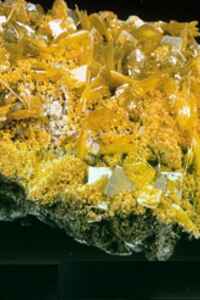In crystallography, the tetragonal crystal system is one of the 7 crystal systems. Tetragonal crystal lattices result from stretching a cubic lattice along one of its lattice vectors, so that the cube becomes a rectangular prism with a square base (a by a) and height (c, which is different from a).
Bravais lattices
Further information: Bravais lattice
There are two tetragonal Bravais lattices: the primitive tetragonal and the body-centered tetragonal.
| Bravais lattice | Primitivetetragonal | Body-centeredtetragonal |
|---|---|---|
| Pearson symbol | tP | tI |
| Unit cell |
The body-centered tetragonal lattice is equivalent to the primitive tetragonal lattice with a smaller unit cell, while the face-centered tetragonal lattice is equivalent to the body-centered tetragonal lattice with a smaller unit cell.1
Crystal classes
Further information: Crystallographic point group
The point groups that fall under this crystal system are listed below, followed by their representations in international notation, Schoenflies notation, orbifold notation, Coxeter notation and mineral examples.23
| # | Point group | Type | Example | Space groups | |||||
|---|---|---|---|---|---|---|---|---|---|
| Name4 | Intl | Schoen. | Orb. | Cox. | Primitive | Body-centered | |||
| 75–80 | Tetragonal pyramidal | 4 | C4 | 44 | [4]+ | enantiomorphic polar | pinnoite, piypite | P4, P41, P42, P43 | I4, I41 |
| 81–82 | Tetragonal disphenoidal | 4 | S4 | 2× | [2+,4+] | cahnite, tugtupite | P4 | I4 | |
| 83–88 | Tetragonal dipyramidal | 4/m | C4h | 4* | [2,4+] | centrosymmetric | scheelite, wulfenite, leucite | P4/m, P42/m, P4/n, P42/n | I4/m, I41/a |
| 89–98 | Tetragonal trapezohedral | 422 | D4 | 224 | [2,4]+ | enantiomorphic | cristobalite, wardite | P422, P4212, P4122, P41212, P4222, P42212, P4322, P43212 | I422, I4122 |
| 99–110 | Ditetragonal pyramidal | 4mm | C4v | *44 | [4] | polar | diaboleite | P4mm, P4bm, P42cm, P42nm, P4cc, P4nc, P42mc, P42bc | I4mm, I4cm, I41md, I41cd |
| 111–122 | Tetragonal scalenohedral | 42m | D2d (Vd) | 2*2 | [2+,4] | chalcopyrite, stannite | P42m, P42c, P421m, P421c, P4m2, P4c2, P4b2, P4n2 | I4m2, I4c2, I42m, I42d | |
| 123–142 | Ditetragonal dipyramidal | 4/mmm | D4h | *224 | [2,4] | centrosymmetric | rutile, pyrolusite, zircon | P4/mmm, P4/mcc, P4/nbm, P4/nnc, P4/mbm, P4/mnc, P4/nmm, P4/ncc, P42/mmc, P42/mcm, P42/nbc, P42/nnm, P42/mbc, P42/mnm, P42/nmc, P42/ncm | I4/mmm, I4/mcm, I41/amd, I41/acd |
In two dimensions
Main article: Square lattice
There is only one tetragonal Bravais lattice in two dimensions: the square lattice.
| Bravais lattice | Square |
|---|---|
| Pearson symbol | tp |
| Unit cell |
See also
External links
- Media related to Tetragonal lattices at Wikimedia Commons
References
Cubic-to-Tetragonal Transition http://www.aem.umn.edu/people/faculty/shield/hane/tet.html ↩
Webmineral data http://webmineral.com/crystal/Tetragonal.shtml ↩
Hurlbut, Cornelius S.; Klein, Cornelis, 1985, Manual of Mineralogy, 20th ed., pp. 73–78, ISBN 0-471-80580-7 /wiki/ISBN_(identifier) ↩
"The 32 crystal classes". Retrieved 2018-06-19. https://www.tulane.edu/~sanelson/eens211/32crystalclass.htm ↩
